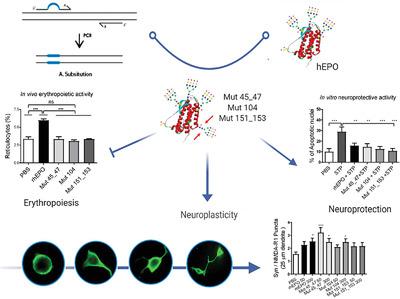当前位置:
X-MOL 学术
›
Biotechnol. J.
›
论文详情
Our official English website, www.x-mol.net, welcomes your
feedback! (Note: you will need to create a separate account there.)
Novel erythropoietin‐based therapeutic candidates with extra N‐glycan sites that block hematopoiesis but preserve neuroplasticity
Biotechnology Journal ( IF 3.2 ) Pub Date : 2021-01-20 , DOI: 10.1002/biot.202000455 Milagros Bürgi 1 , Gabriela Inés Aparicio 2 , Aquiles Dorella 3 , Ricardo Kratje 1 , Camila Scorticati 2 , Marcos Oggero 1
Biotechnology Journal ( IF 3.2 ) Pub Date : 2021-01-20 , DOI: 10.1002/biot.202000455 Milagros Bürgi 1 , Gabriela Inés Aparicio 2 , Aquiles Dorella 3 , Ricardo Kratje 1 , Camila Scorticati 2 , Marcos Oggero 1
Affiliation

|
Neurological disorders affect millions of people causing behavior‐cognitive disabilities. Nowadays they have no effective treatment. Human erythropoietin (hEPO) has been clinically used because of its neurotrophic and cytoprotective properties. However, the erythropoietic activity (EA) should be considered as a side effect. Some analogs like non‐sialylated EPO, carbamylated EPO, or EPO peptides have been developed showing different weaknesses: erythropoiesis preservation, low stability, potential immunogenicity, or fast clearance. Herein, we used a novel strategy that blocks the EA but preserves hEPO neurobiological actions. N‐glycoengineering was accomplished to add a new glycosylation site within the hEPO sequence responsible for its EA. hEPO‐derivatives were produced by CHO.K1 cells, affinity‐purified and functionally analyzed studying their in vitro and in vivo EA, their in vitro neuronal plasticity in hippocampal neurons and their neuroprotective action by rescuing hippocampal neurons from apoptosis. Muteins Mut 45_47 (K45 > N45 + N47 > T47), Mut 104 (S104 > N104), and Mut 151_153 (G151 > N151 + K153 > T153) lost their EA but preserved their neuroprotection activity and enhanced neuroplasticity more efficiently than hEPO. Interestingly, Mut 45_47 resulted in a promising candidate to explore as neurotherapeutic considering not only its biopotency but also its pharmacokinetic potential due to the hyperglycosylation.
中文翻译:

新型基于促红细胞生成素的治疗性候选药物,具有额外的N-聚糖位点,可阻断造血作用,但保留神经可塑性
神经系统疾病影响数以百万计的人,导致行为认知障碍。如今,他们没有有效的治疗方法。人类促红细胞生成素(hEPO)由于其神经营养和细胞保护特性而被临床使用。但是,应将促红细胞生成活性(EA)视为一种副作用。已经开发出一些类似物,如未唾液酸化的EPO,氨基甲酰化的EPO或EPO肽,它们显示出不同的弱点:红细胞生成保存,低稳定性,潜在的免疫原性或快速清除。在本文中,我们使用了一种新颖的策略来阻止EA,但保留hEPO神经生物学作用。完成了N-糖工程改造,从而在负责其EA的hEPO序列中添加了一个新的糖基化位点。hEPO衍生物是由CHO.K1细胞产生的,通过从海马神经元的凋亡中拯救它们的体外和体内EA,海马神经元的体外神经元可塑性及其神经保护作用,对其进行亲和纯化和功能分析。突变蛋白Mut 45_47(K45> N45 + N47> T47),Mut 104(S104> N104)和Mut 151_153(G151> N151 + K153> T153)失去了EA,但比hEPO更有效地保留了其神经保护活性并增强了神经可塑性。有趣的是,Mut 45_47导致了一个有前途的候选者作为神经治疗剂进行探索,不仅考虑了其生物效能,还考虑了由于糖基化过多而引起的药代动力学潜力。N45 + N47> T47),Mut 104(S104> N104)和Mut 151_153(G151> N151 + K153> T153)失去了EA,但比hEPO更有效地保留了其神经保护活性并增强了神经可塑性。有趣的是,Mut 45_47导致了一个有前途的候选者作为神经治疗剂进行探索,不仅考虑了其生物效能,还考虑了由于糖基化过多而引起的药代动力学潜力。N45 + N47> T47),Mut 104(S104> N104)和Mut 151_153(G151> N151 + K153> T153)失去了EA,但比hEPO更有效地保留了其神经保护活性并增强了神经可塑性。有趣的是,Mut 45_47导致了一个有前途的候选者作为神经治疗剂进行探索,不仅考虑了其生物效能,还考虑了由于糖基化过多而引起的药代动力学潜力。
更新日期:2021-01-20
中文翻译:

新型基于促红细胞生成素的治疗性候选药物,具有额外的N-聚糖位点,可阻断造血作用,但保留神经可塑性
神经系统疾病影响数以百万计的人,导致行为认知障碍。如今,他们没有有效的治疗方法。人类促红细胞生成素(hEPO)由于其神经营养和细胞保护特性而被临床使用。但是,应将促红细胞生成活性(EA)视为一种副作用。已经开发出一些类似物,如未唾液酸化的EPO,氨基甲酰化的EPO或EPO肽,它们显示出不同的弱点:红细胞生成保存,低稳定性,潜在的免疫原性或快速清除。在本文中,我们使用了一种新颖的策略来阻止EA,但保留hEPO神经生物学作用。完成了N-糖工程改造,从而在负责其EA的hEPO序列中添加了一个新的糖基化位点。hEPO衍生物是由CHO.K1细胞产生的,通过从海马神经元的凋亡中拯救它们的体外和体内EA,海马神经元的体外神经元可塑性及其神经保护作用,对其进行亲和纯化和功能分析。突变蛋白Mut 45_47(K45> N45 + N47> T47),Mut 104(S104> N104)和Mut 151_153(G151> N151 + K153> T153)失去了EA,但比hEPO更有效地保留了其神经保护活性并增强了神经可塑性。有趣的是,Mut 45_47导致了一个有前途的候选者作为神经治疗剂进行探索,不仅考虑了其生物效能,还考虑了由于糖基化过多而引起的药代动力学潜力。N45 + N47> T47),Mut 104(S104> N104)和Mut 151_153(G151> N151 + K153> T153)失去了EA,但比hEPO更有效地保留了其神经保护活性并增强了神经可塑性。有趣的是,Mut 45_47导致了一个有前途的候选者作为神经治疗剂进行探索,不仅考虑了其生物效能,还考虑了由于糖基化过多而引起的药代动力学潜力。N45 + N47> T47),Mut 104(S104> N104)和Mut 151_153(G151> N151 + K153> T153)失去了EA,但比hEPO更有效地保留了其神经保护活性并增强了神经可塑性。有趣的是,Mut 45_47导致了一个有前途的候选者作为神经治疗剂进行探索,不仅考虑了其生物效能,还考虑了由于糖基化过多而引起的药代动力学潜力。










































 京公网安备 11010802027423号
京公网安备 11010802027423号